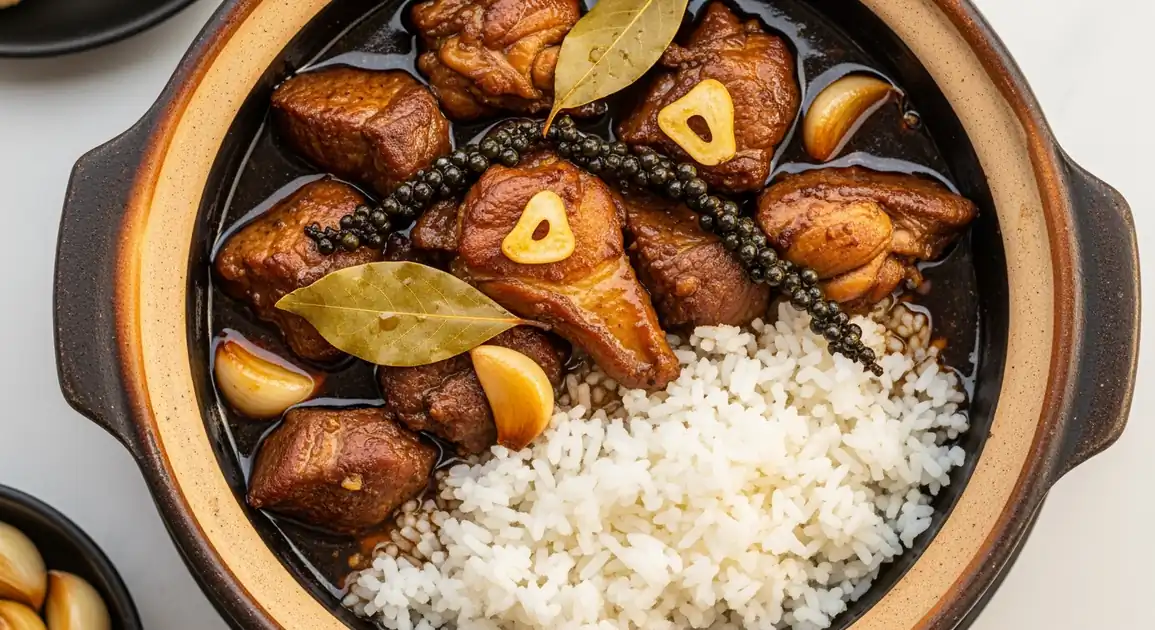Adobo
Adobo

Description
Adobo is considered the unofficial national dish of the Philippines, found in nearly every household and restaurant across the country. While regional variations exist, the core preparation with vinegar, garlic, and either soy sauce or salt remains consistent. Adobo exemplifies Filipino cuisine's hallmark of balancing sour, savory, and sometimes sweet flavors.
Dietary Information
Serving information
Serving style
Typically served family-style in a communal dish or as individual portions with rice. Usually eaten with a spoon and fork, occasionally with hands for bone-in pieces.
Quick facts
Carinderias typically serve adobo from 10 AM - 8 PM. Restaurants offer it throughout their operating hours.
Safety Tips
What to Look For
-
Properly cooked meat that falls off the bone (chicken) or is fork-tender (pork)
Fully cooked meat ensures safety while achieving the ideal adobo texture. The meat should be tender but not mushy.
-
Clear, glossy sauce with visible whole spices
Quality adobo has a reduced, somewhat glossy sauce from rendered fat. The presence of whole peppercorns and bay leaves indicates traditional preparation.
-
Food served hot or properly refrigerated and reheated
While adobo's vinegar and salt act as preservatives, proper temperature control remains important, especially in hot climates.
-
Clean serving environment with proper food handling
Look for vendors who use clean utensils, covered containers, and good hygiene practices.
What to avoid
-
Pre-cooked adobo sitting at room temperature for extended periods
Despite its preservative qualities, adobo should not sit at room temperature all day, especially in hot weather.
-
Excessively oily or greasy appearance
While adobo naturally contains fat, excessive oil floating on top may indicate poor preparation or quality issues.
-
Very dark, almost black sauce
Extremely dark sauce may indicate overuse of soy sauce, burnt garlic, or old, repeatedly reheated adobo.
-
Adobo with an overly sour or fermented smell
While adobo should be tangy, an extremely sour smell might indicate spoilage or poor-quality vinegar.
Price information
Price range
Budget tips
- Carinderias (local eateries) offer adobo for 80-120 PHP per serving with rice.
- Turo-turo establishments (point-point eateries) often have more affordable options.
- University/office canteens typically serve budget-friendly adobo meals.
- For value, look for 'unlimited rice' promotions with adobo orders.
Value indicators
- Generous meat portions with a good meat-to-fat ratio.
- Flavorful sauce that's well-reduced (not watery).
- Tender meat that's properly cooked through.
- Complimentary soup or side dishes included.
- Free sauce refills or extra rice options.
Where to Find This Dish
Local Neighborhoods
Carinderias and small eateries in residential areas serve homestyle adobo.
Small markets, Community centers, Residential streets
Lunch (11 AM - 1 PM), Early Dinner (5 PM - 7 PM)
Business Districts
Office canteens and fast-casual Filipino restaurants cater to workers.
Office buildings, Commercial centers
Lunch (12 PM - 2 PM)
Tourism Areas
Filipino restaurants in tourist zones offer adobo as an introduction to local cuisine.
Cultural centers, Tourist attractions
Lunch (11 AM - 2 PM), Dinner (6 PM - 9 PM)
Vendor Tips
- Ask locals for their recommended adobo places - every Filipino has an opinion on the best adobo.
- Look for restaurants specializing in Filipino cuisine rather than international menus.
- At turo-turo eateries, choose from freshly replenished trays rather than dishes that have been sitting out.
How to Order
Regional Variations
-
Chicken Adobo
(Adobong Manok)
Made with chicken pieces (typically bone-in thighs and legs), resulting in a lighter-colored sauce than pork versions.
-
Pork Adobo
(Adobong Baboy)
Prepared with pork belly or shoulder, producing a richer, fattier dish with more depth of flavor.
-
Chicken and Pork Adobo
(Adobong Manok at Baboy)
The classic combination using both meats, offering varied textures and flavors in one dish.
-
White Adobo
(Adobong Puti)
Traditional version using salt instead of soy sauce, resulting in a pale sauce that highlights the vinegar flavor.
-
Yellow Adobo
(Adobo sa Dilaw)
Uses turmeric instead of soy sauce, giving the dish a golden color and earthy flavor.
-
Adobo with Coconut Milk
(Adobo sa Gata)
Adds coconut milk for a creamier, slightly sweeter sauce, popular in southern regions.
-
Adobo Flakes
(Adobo Flakes)
Leftover adobo meat shredded and fried until crispy, often served for breakfast with fried rice and egg.
Cultural context
History
Adobo's origins blend pre-colonial Filipino cooking methods with influences from Chinese traders (soy sauce) and Spanish colonizers (who named it after their own 'adobar' marinade). Before Spanish contact, Filipinos were already cooking meat in vinegar and salt. The addition of soy sauce came later through Chinese trade. While the Spanish named the dish, Filipino adobo remains distinctly different from Spanish or Latin American versions. Through generations, adobo evolved with regional variations across the 7,000+ Philippine islands, becoming a cultural touchstone that reflects the country's complex history of indigenous practices and foreign influences.
Local significance
Adobo is more than food in the Philippines - it's a cultural symbol representing Filipino ingenuity, adaptability, and family tradition. Often called the unofficial national dish.
Eating customs
- Always eaten with rice, which is considered essential for enjoying the sauce.
- Often served family-style, encouraging sharing.
- Traditionally eaten with a spoon and fork, not knife and fork.
- Leftover adobo is highly prized and reimagined into other dishes like adobo flakes.